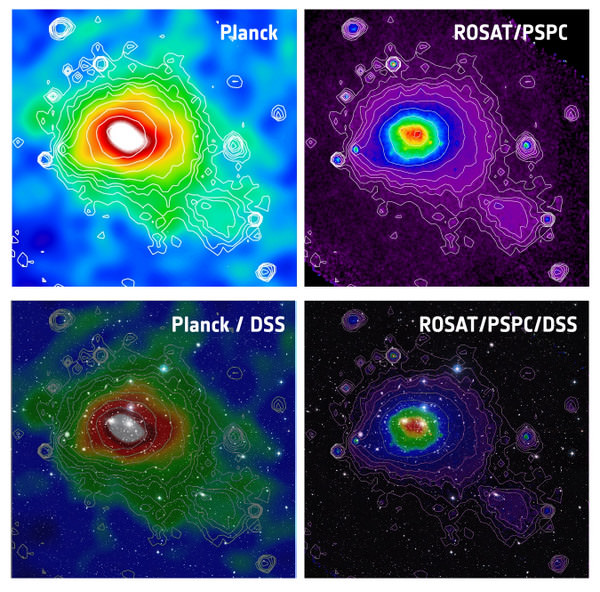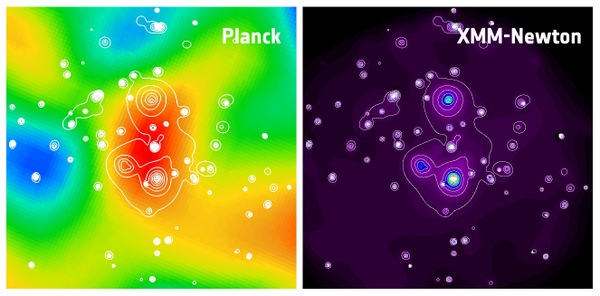[/caption]
Scanning the sky in microwaves, the Planck mission has obtained its very first images of galaxy clusters, and found a previously unknown supercluster which is among one of the largest objects in the Universe. The supercluster is having an effect on the Cosmic Microwave Background, and the observed distortions of the CMB spectrum are used to detect the density perturbations of the universe, using what is called the Sunyaev–Zel’dovich effect (SZE). This is the first time that a supercluster has been discovered using the SZE. In a collaborative effort, the XMM Newton spacecraft has confirmed the find in X-rays.
Sunyaev-Zel’dovich Effect (SZE) effect describes the change of energy experienced by CMB photons when they encounter a galaxy cluster as they travel towards us, in the process imprinting a distinctive signature on the CMB itself. The SZE represents a unique tool to detect galaxy clusters, even at high redshift. Planck is able to look across nine different microwave frequencies (from 30 to 857 GHz) to remove all sources of contamination from the CMB, and over time, will provide what is hoped to be the sharpest image of the early Universe ever.
“As the fossil photons from the Big Bang cross the Universe, they interact with the matter that they encounter: when travelling through a galaxy cluster, for example, the CMB photons scatter off free electrons present in the hot gas that fills the cluster,” said Nabila Aghanim of the Institut d’Astrophysique Spatiale in Orsay, France, a leading member of the group of Planck scientists investigating SZE clusters and secondary anisotropies. “These collisions redistribute the frequencies of photons in a particular way that enables us to isolate the intervening cluster from the CMB signal.”
Since the hot electrons in the cluster are much more energetic than the CMB photons, interactions between the two typically result in the photons being scattered to higher energies. This means that, when looking at the CMB in the direction of a galaxy cluster, a deficit of low-energy photons and a surplus of more energetic ones is observed.
The SZE signal from the newly discovered supercluster arises from the sum of the signal from the three individual clusters, with a possible additional contribution from an inter-cluster filamentary structure. This provides important clues about the distribution of gas on very large scales which is, in turn, crucial also for tracing the underlying distribution of dark matter.

“The XMM-Newton observations have shown that one of the candidate clusters is in fact a supercluster composed of at least three individual, massive clusters of galaxies, which Planck alone could not have resolved,” said Monique Arnaud, who leads the Planck group following up sources with XMM-Newton.
“This is the first time that a supercluster has been discovered via the SZE,” said Aghanim. “This important discovery opens a brand new window on superclusters, one which complements the observations of the individual galaxies therein.”
Superclusters are large assemblies of galaxy groups and clusters, located at the intersections of sheets and filaments in the wispy cosmic web. As clusters and superclusters trace the distribution of both luminous and dark matter throughout the Universe, their observation is crucial to probe how cosmic structures formed and evolved.
The first Planck all-sky survey began in mid-August 2009 and was completed in June 2010. Planck will continue to gather data until the end of 2011, during which time it will complete over four all-sky scans.
The Planck team is currently analyzing the data from the first all-sky survey to identify both known and new galaxy clusters for the early Sunyaev-Zel’dovich catalogue, which will be released in January of 2011.
Source: ESA


I had thought that the Sunyaev-Zel’dovich effect had been detected previously. it is essentially an inverse Compton scattering process. Low energy CMB photons in the mm-cm microwave domain get an energy boost from higher energy electrons in the presence of an intervening galaxy. I read an account on how Sunyaev and Zel’dovich received a lot of grief over this, and it took a lot of effort to make this theory accepted. Of course it is important to correlate these data between Planck satellite and the XXM, for without the XXM data this could be a false positive of a small region with higher energy CMB. This would result in error in the anisotropy measurement and its use in testing inflationary cosmology.
LC
@LBC,
“I had thought that the Sunyaev-Zel’dovich effect had been detected previously.”
You are correct about galaxy clusters being detected using the SZE technique, however this is the first galaxy (super)cluster discovered using the SZE alone (XMM only later confirmed that this was a galaxy cluster). This discovery underscores the usefulness and capability of mm & sub-mm surveys to turn up galaxy clusters previously unseen at other wavelengths (and these galaxy clusters will be at intermediate to high redshifts, very useful indeed).
Gotcha, I should have realized that! I suppose deviations from Gaussian statistics is what tipped the Planck investigators off.
LC
Could this, and similar structures actually be the “Dark Matter”?
The gravitating mass in the galaxy cluster is largely DM. However, free electron zipping about can interact with these photons and boost their energy by inverse Compton scattering. That is the source of the SZ effect.
LC
Is it true that superclusters are difficult to explain by the big-bang standard model? Tully found a sc believed to take 80 billiion years to form, and Huckra & Geller discoverers of the great wall say it took 100 billion years to form. In one area 13 great walls have their inner and outer walls seperated by 7 billion light years, and it fills 1/4 of the diameter of the universe ! Huckra and Geller say it took 150 billion years to form this. Can the big-bang explain this by relativity, and would this mean that what we say is 14.6 billion years may be 150 billion years somewhere else in the universe?
Will these yet to be discovered super (duper?) galaxy clusters have influence the current “missing matter” maths?
sorry, omit “have”
Dark matter particles I do not believe in, show them to me. extra gravity can come from supermassive black holes or super duper clusters e.g. hooke’s law of newtonian motion for plasma spheres around galaxies. no observational facts are necessary, to refute a DM theory that they want to invent and discover. many famous scientists have their own theories to replace the bad components of the standard model. i.m.o. the best theory of the universe has been around a long time i.e. the universe streams visible matter towards ever larger singularities, likely the dark flow is the largest discovered, because the electromagnetic constant ALPHA called the fine-structure constant is roughly aligned with the dark flow direction, and changes all the other presumed constants over space and time, including gravity. With gravity varying over space and time, the dark matter will blow away. HAHA